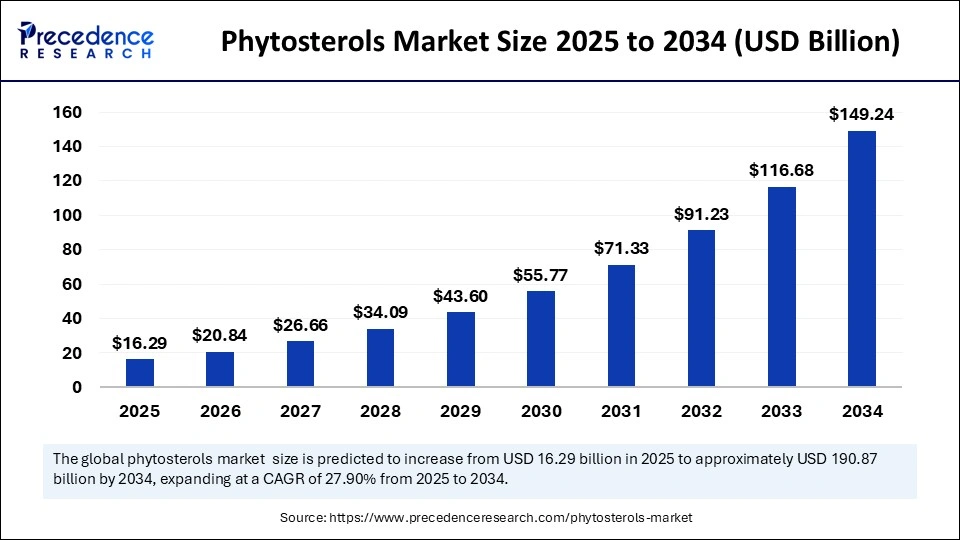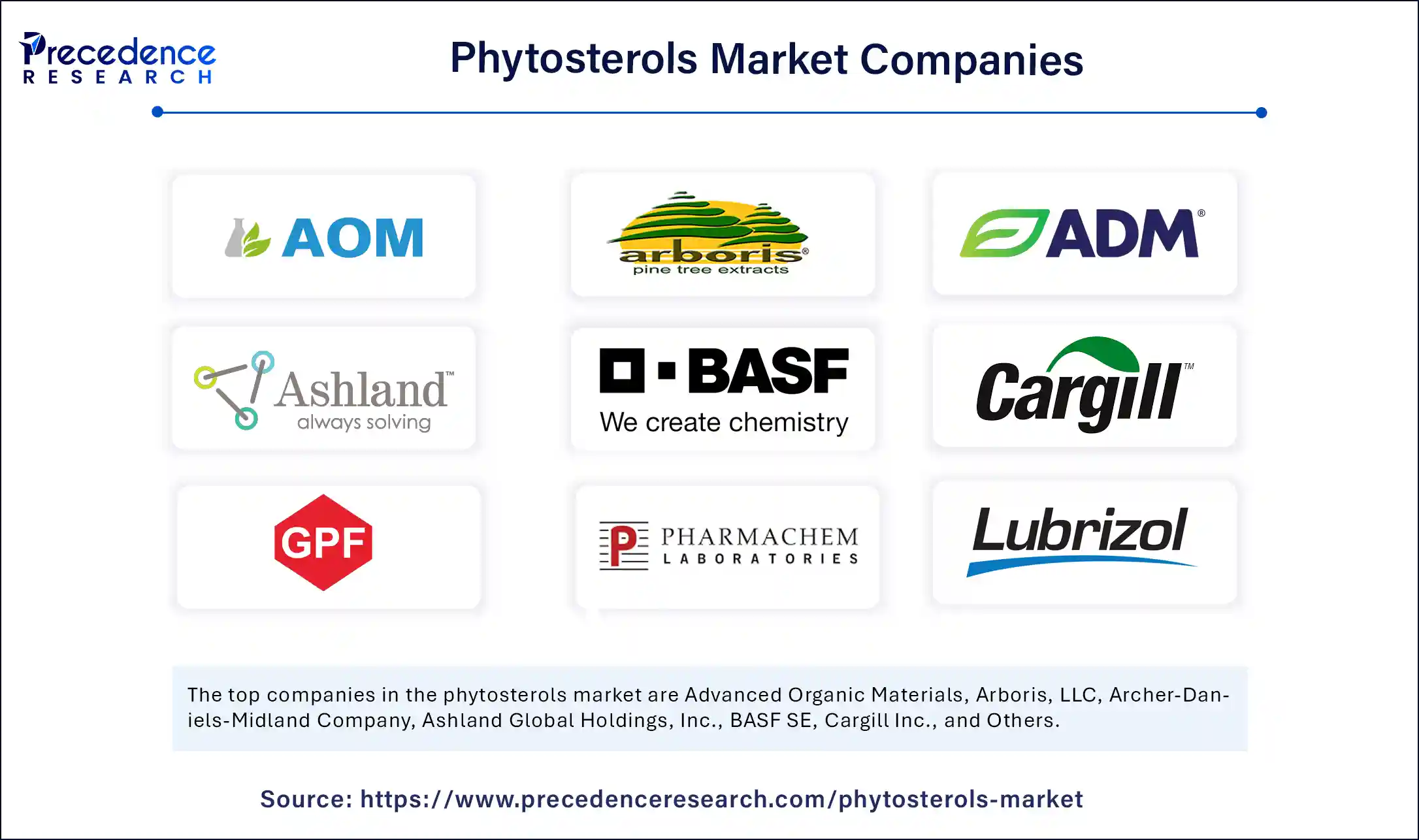
Phytosterols Market Key Points
- In 2024, Europe led the global phytosterols market, accounting for over 52% of the total market share. Meanwhile, North America is projected to expand steadily, registering a CAGR of 9.5% during the forecast period.
- By product type, beta-sitosterol emerged as the leading segment, capturing 60% of the market share in 2024. On the other hand, the campesterol segment is anticipated to grow at a CAGR of 9.5% throughout the forecast timeline.
- In terms of application, food ingredients dominated the market with a 50% share in 2024. The pharmaceuticals segment, however, is expected to witness strong momentum, expanding at a CAGR of 9.7% over the analysis period.
Market Overview
The Phytosterols Market is gaining notable traction globally, driven by the rising demand for natural, plant-based ingredients that contribute to health and wellness. Phytosterols, also known as plant sterols and stanols, are naturally occurring compounds found in the cell membranes of plants. Structurally similar to cholesterol, they have been scientifically proven to help lower LDL (low-density lipoprotein) cholesterol levels in humans by blocking its absorption in the intestines. This cholesterol-lowering property makes phytosterols a valuable ingredient in functional foods, dietary supplements, and pharmaceutical formulations targeting cardiovascular health.
As consumer preferences shift towards preventive healthcare and clean-label ingredients, phytosterols are being increasingly incorporated into a wide range of products, including margarine, dairy substitutes, baked goods, yogurts, and fortified beverages. Additionally, the rise of vegan and vegetarian lifestyles is promoting the consumption of plant-based functional compounds, further strengthening the market. Regulatory approvals from health authorities such as the U.S. FDA and the European Food Safety Authority (EFSA) that permit health claims on cholesterol reduction have also enhanced consumer confidence, thereby contributing to market growth. The market is characterized by growing investments in R&D to enhance extraction techniques, improve bioavailability, and expand application areas.
Growth Factors
The phytosterols market is expanding steadily, supported by several compelling growth factors. Foremost among these is the growing global burden of cardiovascular diseases, which remains the leading cause of mortality. As people become more health-conscious, the demand for ingredients that promote heart health—like phytosterols—is on the rise. This trend is further bolstered by aging populations in developed countries, where preventive dietary measures are widely promoted.
Additionally, rising disposable incomes and awareness of lifestyle-related diseases in emerging markets such as China, India, and Brazil are stimulating interest in functional and fortified foods. Consumers in these regions are becoming more receptive to food products that offer additional health benefits beyond basic nutrition, giving phytosterol-fortified products a stronger foothold.
Another key growth factor is the expansion of the nutraceutical and functional food industries, which are actively seeking bioactive compounds to differentiate their product offerings. Innovations in formulation techniques have allowed manufacturers to incorporate phytosterols into non-traditional products like confectionery, snacks, and beverages without compromising taste or texture. Furthermore, sustainability-driven food manufacturing is encouraging the use of plant-based compounds, positioning phytosterols as eco-friendly and health-positive additives.
Impact of AI on the Phytosterols Market
Artificial Intelligence (AI) is playing a transformative role in optimizing various aspects of the phytosterols market, particularly in product development, supply chain efficiency, and consumer behavior analysis. In R&D, AI and machine learning algorithms are being used to model molecular interactions, helping researchers understand how phytosterols function at the biochemical level. This accelerates the development of new formulations with improved bioavailability and efficacy, especially when phytosterols are combined with other functional ingredients.
AI is also streamlining the extraction and production processes. By analyzing data from raw material inputs, temperature controls, and solvent usage, AI systems can optimize extraction yields from plant sources like vegetable oils, soybeans, and nuts. This results in more cost-effective and sustainable production, reducing waste and enhancing scalability.
In marketing and consumer engagement, AI tools analyze consumer purchase patterns, health trends, and social media sentiment to provide actionable insights into what drives phytosterol product adoption. This helps brands design more targeted campaigns, introduce region-specific products, and identify emerging demand trends.
Moreover, AI supports quality assurance and regulatory compliance by automating real-time monitoring of product specifications during manufacturing. This ensures that phytosterol-enriched products consistently meet safety and efficacy standards set by global regulatory bodies, which is crucial in maintaining brand trust.
Market Drivers
-
Increased prevalence of cardiovascular and lifestyle-related diseases, prompting consumers to adopt heart-healthy diets.
-
Strong regulatory support for phytosterols as safe and effective cholesterol-lowering agents, including health claim approvals by global agencies.
-
Growth of the functional food and nutraceutical industries, which seek plant-based bioactive compounds to enhance their product portfolios.
-
Consumer preference for natural, clean-label, and plant-based ingredients, aligning with global health and sustainability trends.
-
Innovation in food processing and encapsulation technologies, enabling the integration of phytosterols into a broader range of food and beverage formats.
Opportunities
-
Expanding product applications beyond traditional margarine and spreads, into snacks, energy bars, milk alternatives, and even beauty and skincare products, due to the anti-inflammatory and antioxidant properties of phytosterols.
-
Increased demand for personalized nutrition and preventive healthcare, where consumers seek customized supplements and functional foods based on genetic or biometric data.
-
Emergence of new extraction technologies, such as supercritical CO₂ extraction, which offer more sustainable and cost-efficient production options.
-
Rising interest in phytosterol-rich formulations in sports and wellness nutrition, where cardiovascular support is gaining importance.
-
Potential in pharmaceutical research, where phytosterols may be explored as adjunct treatments for metabolic disorders, inflammation, and even certain cancers.
Challenges
-
High production and formulation costs, especially when maintaining product stability and sensory quality in enriched food items.
-
Low solubility and bioavailability of phytosterols, which can limit their efficacy unless paired with delivery enhancers or emulsification technologies.
-
Consumer skepticism or lack of awareness in certain regions, where the benefits of phytosterols are not well understood or widely marketed.
-
Regulatory disparities and labeling complexities, as different regions have varying standards for health claims, maximum allowable dosages, and fortification levels.
-
Market competition from alternative cholesterol-lowering compounds, such as omega-3 fatty acids, plant fibers, and pharmaceutical statins.
Market Scope
| Report Coverage | Details |
| Market Size by 2034 | USD 2.73 Billion |
| Market Size in 2025 | USD 1.20 Billion |
| Market Size in 2024 | USD 1.10 Billion |
| Market Growth Rate from 2025 to 2034 | CAGR of 9.52% |
| Dominating Region | Europe |
| Fastest Growing Region | North America |
| Base Year | 2024 |
| Forecast Period | 2025 to 2034 |
| Segments Covered | Product, Application, and Region |
| Regions Covered | North America, Europe, Asia-Pacific, Latin America, and Middle East & Africa |
Regional Outlook
Europe is the leading market for phytosterols, largely due to strong regulatory frameworks, high consumer health consciousness, and the widespread popularity of fortified foods. The European Union’s early endorsement of phytosterol-related health claims has created a favorable environment for innovation and consumer trust.
North America is another significant market, with growing demand for natural heart health products and a mature functional food industry. The U.S. Food and Drug Administration’s approval of health claims for phytosterols has accelerated adoption in products like dairy alternatives, cereals, and meal replacement bars.
Asia-Pacific is expected to experience the fastest growth, fueled by urbanization, rising disposable incomes, and growing awareness of chronic disease prevention. China, India, and Japan are emerging as major consumer bases for fortified food and dietary supplements. Additionally, the region is rich in plant oil production, providing a steady raw material supply for phytosterol extraction.
Latin America, the Middle East, and Africa represent emerging markets with untapped potential. While current market penetration is low, the rise of lifestyle diseases and growing interest in functional foods are likely to drive future demand. Strategic investments in awareness campaigns and distribution channels will be critical in unlocking these regions.
Phytosterols Market Companies

- Advanced Organic Materials
- Arboris, LLC
- Archer-Daniels-Midland Company
- Ashland Global Holdings, Inc.
- BASF SE
- Cargill Inc.
- Gustav Parmentier GmbH.
- Pharmachem Laboratories, Inc.,
- The Lubrizol Corporation
Segments Covered in the Report
By Product
- Stigmasterol
- Campesterol
- Beta-Sitosterol
- Others
By Application
- Cosmetics
- Food Ingredients
- Pharmaceuticals
By Region
- North America
- Europe
- Asia Pacific
- Latin America
- Middle East & Africa
Read Also: Pass by Noise Testing Market
Get this report to explore global market size, share, CAGR, and trends, featuring detailed segmental analysis and an insightful competitive landscape overview @ https://www.precedenceresearch.com/sample/6085
You can place an order or ask any questions, please feel free to contact at sales@precedenceresearch.com|+1 804 441 9344